CEO Talks: Stephanie Linnartz’s Game Plan for Under Armour
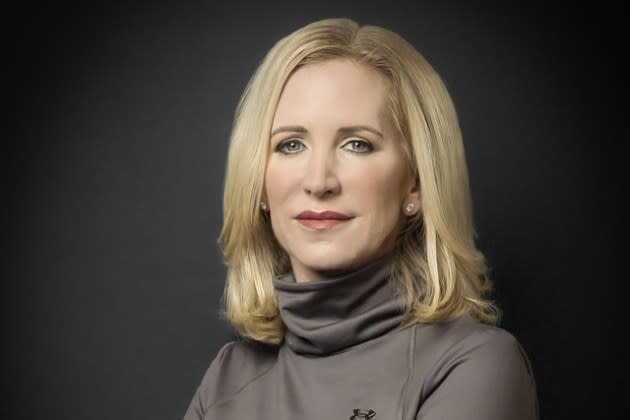
Stephanie Linnartz wasn’t the first name to come to mind when she was tapped to become Under Armour’s chief executive officer in February. Until then she had spent the bulk of her career at Marriott International, rising through the ranks to become president of the world’s largest hospitality company.
Since joining the activewear company, she has shaken up the C-suite and identified a strategy called “Protect This House 3,” which is designed to raise awareness of the Under Armour brand, deliver elevated designs and products to boost U.S. sales and maintain the company’s momentum overseas.
More from WWD
Under Armour's Stephanie Linnartz Applies Lessons Learned at Marriott to New Role
10 Highlights From WWD x FN x Beauty Inc's Women in Power Event
EXCLUSIVE: Under Armour Names John Varvatos Chief Design Officer
One of her biggest moves came earlier this month when she named John Varvatos chief design officer, a move that left industry executives scratching their heads given Varvatos is primarily known for founding his namesake luxury menswear brand, which he is no longer involved with, as well as the OTD label, which has shuttered. But Linnartz is convinced his addition to the team will help the company compete more effectively on the lifestyle end of the business.
Here, in one of her first in-depth interviews since taking the reins, Linnartz discusses the commonalities between Marriott and Under Armour, her plans to increase the women’s business and unique management style.
WWD: Why did you want to join Under Armour after a long, successful career at Marriott?Stephanie Linnartz: I wanted to lead a company, and I saw tremendous potential. When you think about the unaided brand awareness of Under Armour versus the size of the company, it screams “opportunity” to me. And I wanted to do something different and build a company. When you go through something like COVID and then see your dear friend die [Arne Sorenson, CEO of Marriott International], it makes you just want to do something different, take a risk. That’s why I decided to go for it.
WWD: What are the commonalities and the differences between working in hospitality and a sports brand?
S.L.: Under Armour is more of a turnaround. Marriott was already the biggest hotel company. When I think about what I loved about Marriott, it was growing it from a small company to the biggest. But I was done — Marriott couldn’t get any bigger. But what is true of both is that they’re consumer-facing brands. How do you create love for the brand and the product? Is a Ritz-Carlton hotel always better than a Four Seasons? Is the hammer at Home Depot better than a hammer at Lowe’s? Is a fabulous pair of pants at Under Armour better than Nike? If you don’t have a great product, forget about it. But I think it’s about building love for the brand.
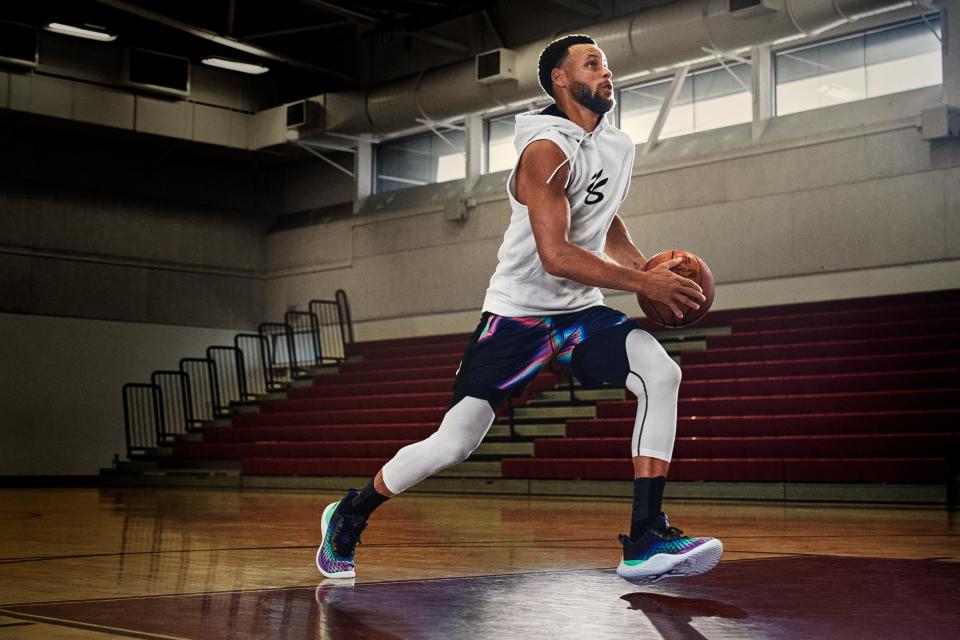
WWD: How do you do that?
S.L.: A brand isn’t one thing, it’s everything — it’s the product, it’s the marketing, it’s the distribution, it’s the people, it’s the culture. That’s what I learned at Marriott International. And that’s what I want to bring to Under Armour. In my old job, I would work with travel bloggers, and Travel & Leisure magazine, but in this job, I’m dealing with Steph Curry. The tactics are a little different, but fundamentally they’re the same.
WWD: And what about the marketing? Under Armour has historically produced inspiring, high-energy videos and photos of athletes at the top of their game. Will that change?
S.L.: There’s a lot of that in travel, too, just inspiring in a different way. There are always snackable bites and content on digital and social but [at Under Armour], it’s consumed by exercise. There’s a difference inspiring someone to run a marathon and inspiring someone to go to a five-star hotel.
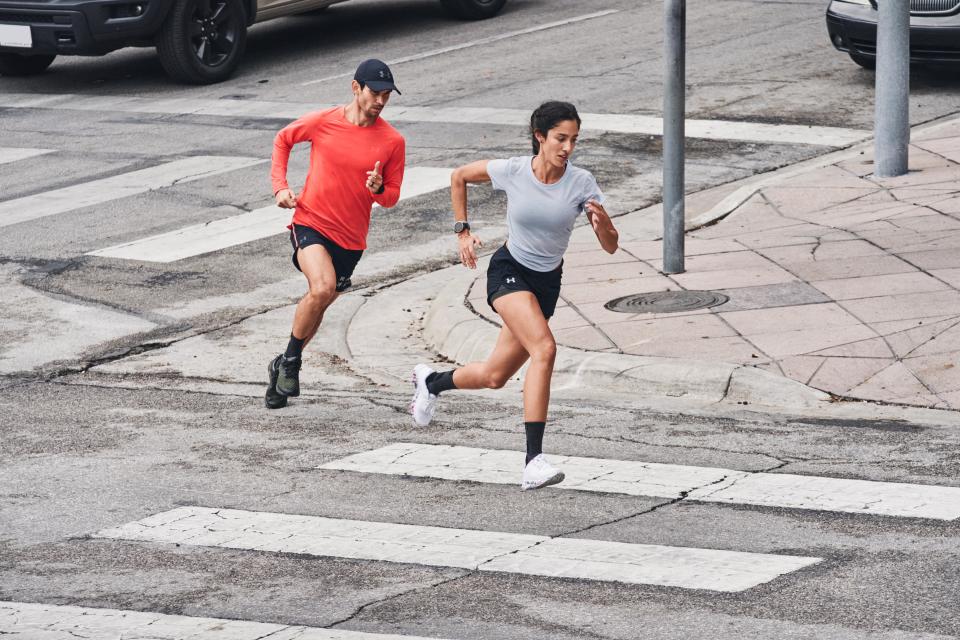
WWD: Since you joined, you’ve made a couple of key changes in the C-suite with the head of product exiting and bringing in John Varvatos as chief design officer. What skill set do you look for in top management?
S.L.: If we’re going to focus on designing and delivering better product with better fit that is on trend but still very rooted in performance, we need to bring some new talent on board. I have a funny story from my past life that relates to this. We did a big hotel deal with Ian Schrager for the Edition hotels and they called us strange bedfellows. But it was a fabulous partnership where the best of both worlds were brought together. That always stuck with me. I think to some extent, people might think Under Armour and John Varvatos might be strange bedfellows, too, but I know it’s going to be fabulous. He’s been working with us for six or seven months already and he’s just a great person. He’s bringing a lot of the things that we needed at Under Armour in terms of design. We have amazing people that know how to make performance product — we can go head-to-head with anybody on the quality and the technical capabilities of our fabrics. But what we were missing to some extent was the style.
WWD: Are there other parts of the company that need to be updated?
S.L.: Our digital capabilities are not fabulous. I have a vision for our website and our app. I know what excellent looks like, and so does Jim Dausch, our new chief consumer officer. And we’re going to build that at Under Armour. So I’m looking at where we are really good and where we are not as good and trying to fill in those gaps with people who will then bring in other people and build out our capabilities.
WWD: Is this part of the “Protect This House 3” strategy you’ve started to implement?
S.L.: “Protect This House” was a very famous ad campaign from the early days and I think it speaks to the DNA of Under Armour, which is very gritty, winning, performance, athletic. I love that. And when you’re going to transform a company, I think it’s important to brand it and name it and get people super psyched about it. “Protect This House 3” refers to three big things we’ll be doing over three years. It’s really three-cubed. Chapter one: get big fast, grow, grow, grow, grow, grow, the Kevin Plank days. Chapter two was a bit of a reset during some tougher times. The CEO before me did put good things in place around operational discipline, supply chain, etc. But now I’m leading chapter three, which is the pivot back to growth.
WWD: What has been the reaction so far?
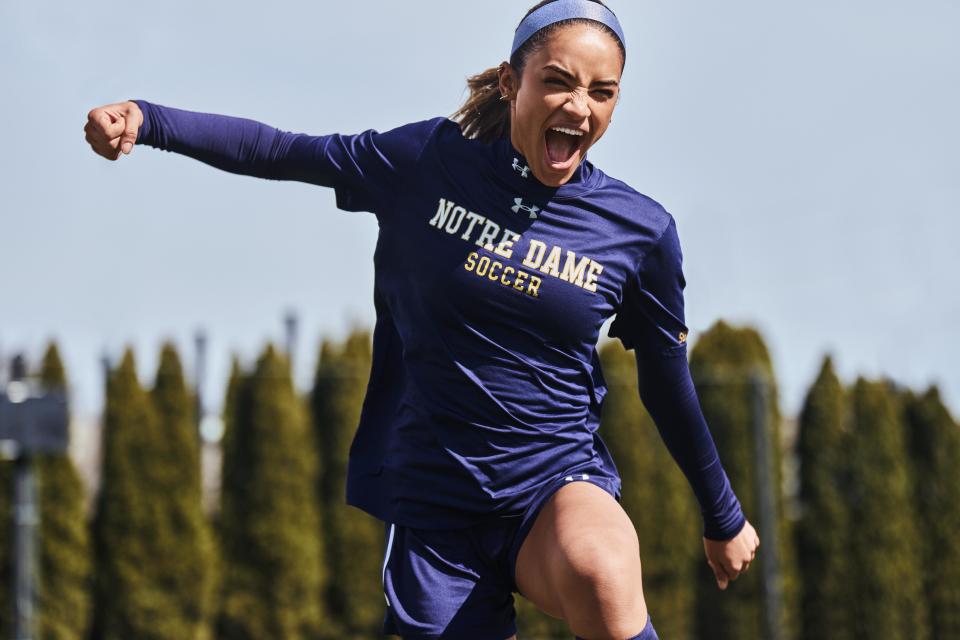
S.L.: We’re getting people excited about what this means for the company, and more importantly, getting our teammates and our athletes excited about what it means for them. We just re-signed our deal with Notre Dame, which is fabulous. As part of this deal, we have way more access to their athletes to help us cocreate products. We’ve created an affiliate program where they can sell Under Armour merchandise and get a commission. We can also leverage their social reach, so we’re really leaning into that. I came from the big giant [Marriott], and now we’re the underrated underdog, so you have to be a little more scrappy and think differently, which is scary at times, but also super fun.
WWD: You mentioned the former CEO, Patrik Frisk. His big push was to focus almost exclusively on sport performance product rather than lifestyle. But with John Varvatos coming on board, will you be moving back in the lifestyle direction like your competitors at Adidas and Puma?
S.L.: I don’t think the shift is as drastic as people think. First of all, Patrik did a lot of good things for Under Armour. But his focus was on performance. But without beauty, there can be no performance — they’re not mutually exclusive. We’re not talking about sundresses and clogs and I don’t like the term “sports style.” We’re still focused on the athlete, we just want more of their closet, more of their wallet. We don’t want to just be on athletes when they’re sweating and training but also when they’re going out to Starbucks with their friends or teammates. We want that part of their day. These days, everyone wears sports style 24/7 and we’re still focused on the 16-to-24-year-old team sport varsity athlete. But we’re just opening the aperture a little bit. It’s not like we’re doing a total about-face.
WWD: There was also a move to significantly cut back on your wholesaling under the former CEO as well, with Under Armour exiting 2,000 to 3,000 doors in North America. But you just cut a deal with Macy’s to bring back the menswear. What’s your thinking about wholesale?
S.L.: I think to grow, we need to do both. We need to embrace our wholesale partners, we need to be more disciplined in our product segmentation, but they’re inextricably linked. Omnichannel is the buzzword of the day. Having Under Armour full-price stores are going to drive e-comm sales and wholesale sales. It’s an interconnected web. When you go into Dick’s Sporting Goods, Under Armour is going to be more top-of-mind. So I think it’s all interconnected. I bring this from my past life: you want people to buy hotel rooms on marriott.com but you also want them to buy them on booking.com — it’s kind of the same thing. Sometimes people aren’t brand-loyal. But you need to work with partners who give you more depth and breadth and reach than you can have on your own. I’m still learning this industry, but everybody plays in all channels. It’s just how you do it.
WWD: You also recently launched a loyalty program, UA Rewards. How does that fit into the picture?
S.L.: I think the loyalty program is going to help us build more stickiness. The loyalty program at Marriott was world-class — the Bonvoy program has 180 million members. But it can’t just be transactional. It needs to be about building experiences into the loyalty program. This is another example where I think my past life and this life are so similar.
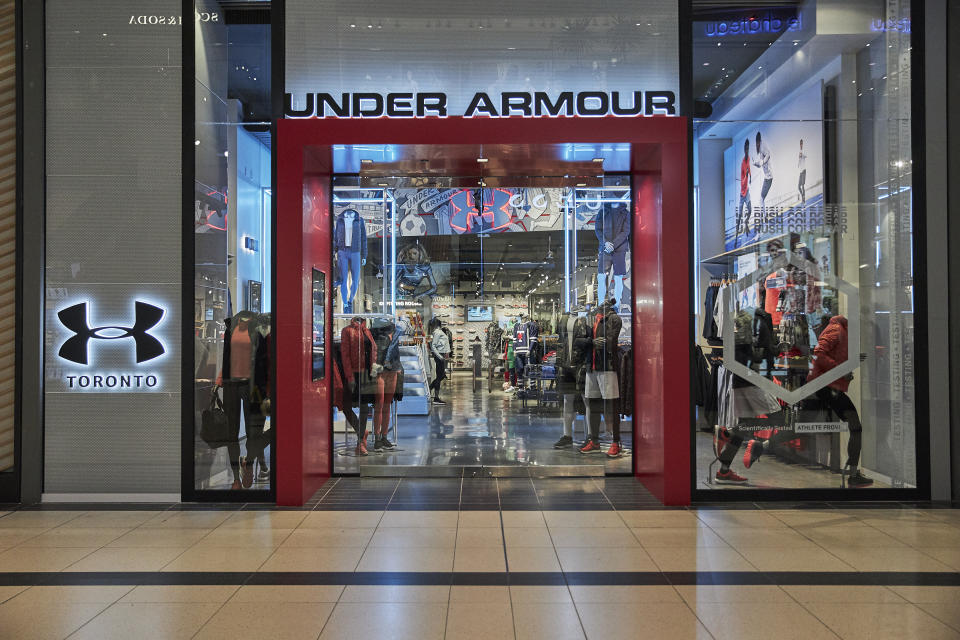
WWD: Let’s talk about your retail stores. The former team had planned to open a Brand House on Fifth Avenue and 58th Street in New York, but that never happened. Do you have an update on that and the other stores in your fleet?
S.L.: It was before my time, but we took a restructuring charge and we’re looking to sublet that space. The strategy now is to just focus on the U.S. because I think it’s different around the world. We have about a 90-10 mix of outlets to full-price stores, it should be more like 75-25. We need more full-price brand stores because they are the highest articulation of our brand. The same with our digital assets: they must be the epitome of what Under Armour stands for. We’re laying out a plan about where we’re going to open more physical retail. And I think about it from an omni perspective. Accenture did an interesting study recently that I read: when a Macy’s physical store closes, all their e-comm sales dry up in that same micro zip code, which is quite fascinating. It just underscores the point of interconnectivity. I brought in a fabulous gentleman to run retail for us, Josh Denton — he came from Gap/Old Navy, and he is leading our retail strategy globally. And John Varvatos is a great retailer. He has some some terrific insights that have been really helpful. So I’ve been tapping into him beyond just the design part.
WWD: Speaking of John Varvatos, his background doesn’t include activewear or womenswear, so why is he the right man for the design job?
S.L.: He loves Under Armour, he’s got a great relationship with Kevin, he’s got an apartment in Baltimore. It’s an easy train ride from New York. We have three design centers — Baltimore, New York and Portland — and John is overseeing all three, and we will likely build out more capabilities in New York. And again, it’s not just about the one hire. I’ve learned that when you bring in a superstar, they bring in superstars. It sounds so basic, but that’s the way it works.
WWD: Let’s talk a little bit about the culture. It’s been very male-driven with a focus around male sports. Will you be making a shift to make it more inclusive?
S.L.: To be honest with you, I really don’t find it is all that male-dominated, I really don’t. There are a lot of women at Under Armour. There’s a lot of diversity. From a consumer perspective, yes, Under Armour really wins with men in terms of apparel — it is seen as more of a men’s apparel brand, but inside of the company, there’s a lot of diversity. Fifty percent of my direct reports are women. But to attract more women, we need to market differently. How do I get more social influence? Maybe we need to work with celebrities that are more sports-oriented. Not just female athletes but some of these actresses that we always see courtside at a Lakers game. How do we lean into people who are both social influencers and love sports and athletics to promote our brand? It’s a little bit of a different twist, but I think it will help us connect with women.
WWD: Recently there’s been enormous buzz around women’s sports with 92,000 people showing up for a Nebraska volleyball game. And the women’s World Cup was also extremely popular. But interest tends to wane shortly after these big events. How do you maintain the momentum?
S.L.: First of all, I don’t do it alone, I partner with other women who work in businesses tied to sports. I sat next to Sheila Johnson at a dinner last night and she’s part owner of the [Washington] Mystics [of the WNBA]. And I know Cathy Engelbert, commissioner of the WNBA, from when she was CEO of Deloitte. All the worlds are interconnected. So how do I contribute? Well, first of all, I make better stuff for female athletes — that’s the most important thing I can do. Then we have to figure out how to include them in our marketing and increase our sub-25 percent business with women. Why can’t it be 50 percent? I’m not saying that’s a goal right now, but it’s certainly got to be a lot more. I can do my small part in this big ecosystem of sports by partnering with others and most importantly, creating great products for female athletes that they love.
WWD: And finally, how would you describe your management style?
S.L.: I went to a Jesuit College, which is all about servant leadership. And that’s kind of my style. I’m the coach of the team, to use a sports analogy. I don’t need to be the star. And I’m a good listener — I deeply care about people. I deeply care about having a diverse team. I don’t need to hire only a bunch of superstars. What if they don’t work well together? But I think I’m a very good team builder.
WWD: Do you have a mentor or someone you admire in business?
S.L.: The CEO I admired most was Arne Sorenson [who passed away from pancreatic cancer in 2021]. He was still my role model and mentor because he was a people-first leader. He didn’t have a giant ego. He was a good person, a man of faith and family, so even though he’s not here anymore, that’s the person that always comes to my mind.
Best of WWD

